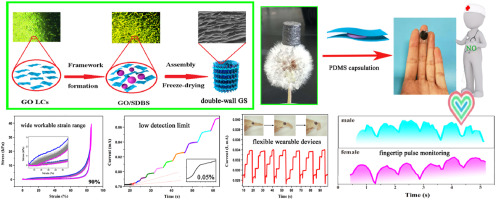Abstract
Piezoresistive sensor based on flexible three-dimensional graphene oxide (3DGO) is regarded as one of the most significant components for the next generation of wearable electronics. Despite the promising potential, the sensitivity of 3DGO piezoresistive sensors is severely restricted by its disordered microstructure and internal elastic defects to capture tiny signals. Although considerable efforts have been dedicated to improving its performances by chemical reduction and subsequent freeze-drying processes, it is still a huge challenge to achieve a 3D GO-based sensor coupled with ultra-high sensitivity and low detection limit simultaneously. Here, a simple and cost-effective strategy is proposed to reconstruct its pristine disordered skeleton by inducing GO liquid crystals (GO LCs) with a daily-used surfactant of sodium dodecyl benzenesulfonate (SDBS), and then the flexible and ultralight 3D GO/SBDS (GS) composite aerogel with double-walled honeycomb-like architecture is successfully fabricated. The prepared 3D GS composite aerogel exhibits significantly improved sensing performances with a fine sensitivity of 1.48 kPa(-1), a low detection limit of 0.05% strain, a fatigue resistance exceeding 10,000 cycles, and a fast response time of 20.86 ms. Importantly, the sensitive sensor has been applied in monitoring real-time fingertip pulse, offering a competitive alternative for the existed complex health monitoring systems. (C) 2021 Elsevier Ltd. All rights reserved.

Keywords Plus:GRAPHENE OXIDEADSORPTIONMEMBRANES
Published in CARBON,Volume184,53-63;10.1016/j.carbon.2021.08.010,OCT 30 2021


